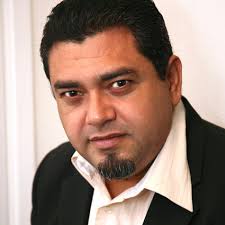12.19.23 Francisco José Freeman (Coco Freeman).

Francisco José Freeman, popularly known and known since childhood as Coco Freeman, is a prominent Cuban singer. He was born in Palma Soriano, in the eastern Cuban province of Santiago de Cuba. From a very young age, he was fascinated by singing, learning every song he heard on the radio. He gave concerts at his home for visitors and participated in every school activity as a talented and enthusiastic student. Coco Freeman possesses a powerful voice and a distinctive timbre.
In 1988, he began working in a cabaret in his hometown that was inaugurated. In 1990, he left for Havana, where he was recruited by the Nueva Trova group Girón, from the University of Havana. A month after his arrival in the capital, he was evaluated and began his career as a professional artist alongside renowned musicians such as Augusto Enrique and Mayito Rivera.
Four years later, in 1994, Francisco José Freeman was called by the great Cuban musician Adalberto Álvarez to join his orchestra, replacing Rojitas. In 1996, he joined the NG la Banda orchestra, directed by José Luis Cortés, where he remained for six years. This group was a great training ground for Coco, a great challenge for him, and it prepared him for his subsequent solo career.
He began his solo career in 2004, and around this time he was also invited to participate in the album Rythms del Mundo. This project was led by the English association Artists’ Project Earth, which sought out faithful exponents of traditional Cuban music, such as the Buenavista Social Club.
The goal of this album was to help those in need and those affected by the calamities caused by global warming. International music figures such as Coldplay, U2, Sting, Dido, and others participated in the album, as well as Cuban musicians such as Omara Portuondo and Ibrahim Ferrer. She performed the song “I Still Haven’t Found What I’m Looking For” on the album.
In February 2010, Coco Freeman participated in the renowned Viña del Mar Festival, held at the Quinta Vergara Amphitheater in Chile, before a capacity of over 15,000 spectators. At the event, she performed the song Para vivir by Pablo Milanés. She had a successful performance in the international competition, reaching the finals with an Argentine and an Italian artist. Unfortunately, the event was interrupted by an earthquake.
To celebrate his 21st anniversary in 2011, he embarked on a national tour. He has also been working on a new album this year, which he plans to release with previously unreleased songs. He also recorded Habana de Lujo (Havana de Lujo) with a French label, a production designed for European release.
Francisco José Freeman presents Habana de Lujo, an international repertoire of songs and boleros, with well-known hits such as Inolvidable, Contigo en la distancia, Cuando ya no me quieres, and Gracias a la vida. The show features artists such as Ela Calvo, Germán Velazco, and Pancho Amat, among others.








